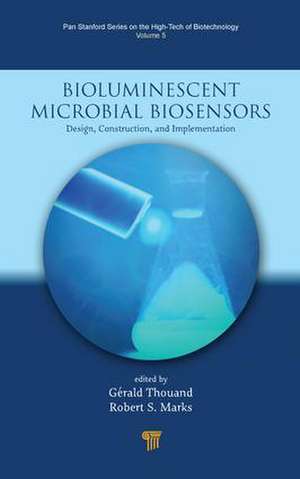Bioluminescent Microbial Biosensors: Design, Construction, and Implementation: Jenny Stanford Series on the High‐Tech of Biotechnology
Editat de Gerald Thouand, Robert S. Marksen Limba Engleză Hardback – 2 dec 2015
Preț: 653.08 lei
Preț vechi: 876.83 lei
-26% Nou
Puncte Express: 980
Preț estimativ în valută:
124.98€ • 135.71$ • 104.98£
124.98€ • 135.71$ • 104.98£
Comandă specială
Livrare economică 01-15 aprilie
Doresc să fiu notificat când acest titlu va fi disponibil:
Se trimite...
Preluare comenzi: 021 569.72.76
Specificații
ISBN-13: 9789814613651
ISBN-10: 9814613657
Pagini: 236
Ilustrații: 87
Dimensiuni: 152 x 229 mm
Greutate: 0.47 kg
Ediția:1
Editura: Jenny Stanford Publishing
Colecția Jenny Stanford Publishing
Seria Jenny Stanford Series on the High‐Tech of Biotechnology
ISBN-10: 9814613657
Pagini: 236
Ilustrații: 87
Dimensiuni: 152 x 229 mm
Greutate: 0.47 kg
Ediția:1
Editura: Jenny Stanford Publishing
Colecția Jenny Stanford Publishing
Seria Jenny Stanford Series on the High‐Tech of Biotechnology
Public țintă
Academic and PostgraduateCuprins
Luminescent Biosensors with Free Suspended Cells. Fully Automated Fluidic Analyzer for Food Quality Assessment Using Bioluminescent Biosensors. Technological Design of Optical Bacterial Biosensors for the Online Environmental Monitoring of Water Pollutants. Luminescent Biosensors with Immobilized Cells. Fiber Optic Biosensors for Environmental Monitoring. Non-Fiber Optic Bioluminescent Biosensors. Biosensor with Immobilized Cells and Lensless Imaging Detection Luca CeveniniaA biosensor with Genetically Modified Bacteria Immobilized on a Fiber and a Glass Slide. Development and Characterization of a Living-Cell Bioluminescent Bioreporter Integrated Circuit (BBIC). BOD Sensor with Immobilized Luminous Cells on ChipBioluminescent Whole-Cell Sensors: Integration of Bacterial Reporter Cells onto Hardware Platforms. Luminescent Biosensors with Bioluminescent Sporulated Cells ("Sporosensor"). Luminescent Biosensing Systems Based on Genetically Engineered Spore-Forming Bacteria.
Notă biografică
Gérald Thouand is full professor in microbiology at the University of Nantes, deputy for research innovation at the French Ministry of Research (DRRT Pays de La Loire), and auditor at the Institute of Higher Studies for Science and Technology, Paris. He received his PhD in microbiology from the University of Nancy, France, in 1993. His research interests include environmental monitoring of biodegradation and biotechnology using microbial biosystems. He is mainly involved in the development of biosensors for the detection of chemical pollutants and pathogenic bacteria. Prof. Thouand is a member of the French Society of Microbiology, France; the Society for Applied Microbiology, UK; and the scientific committee of the International Society of Bioluminescence and Chemiluminescence. He is associate editor for Frontiers in Microbiology and editor for Environmental Science and Pollution Research. His scientific contribution includes 44 international peer-reviewed articles, 4 patents, 12 book chapters, and 59 international conferences.
Robert S. Marks earned his PhD from the Weizmann Institute of Science and did his postdoctoral research at the University of Cambridge. He is full professor at the Department of Biotechnology Engineering, the Ben-Gurion University of the Negev, Israel, and is affiliated to the National Institute for Biotechnology in the Negev and the Ilse Katz Centre for Nanotechnology. He is currently a program coordinator for the NRF CREATE program "Nanomaterials for Water and Energy Management" through MSE at the Nanyang Technological University. Prof. Marks has published in viral immunosensors and has extensive experience in biosensors. He has developed new sensor configurations, such as establishing diagnostics based on luminescence emitted by primed neutrophils, and is the editor-in-chief of the 2007 two-volume Wiley Handbook in Biosensors and Biochips as well as author of more than 100 papers and numerous chapters.
Robert S. Marks earned his PhD from the Weizmann Institute of Science and did his postdoctoral research at the University of Cambridge. He is full professor at the Department of Biotechnology Engineering, the Ben-Gurion University of the Negev, Israel, and is affiliated to the National Institute for Biotechnology in the Negev and the Ilse Katz Centre for Nanotechnology. He is currently a program coordinator for the NRF CREATE program "Nanomaterials for Water and Energy Management" through MSE at the Nanyang Technological University. Prof. Marks has published in viral immunosensors and has extensive experience in biosensors. He has developed new sensor configurations, such as establishing diagnostics based on luminescence emitted by primed neutrophils, and is the editor-in-chief of the 2007 two-volume Wiley Handbook in Biosensors and Biochips as well as author of more than 100 papers and numerous chapters.
Descriere
This book describes the design and the use of bioluminescent biosensors. It introduces beginners and experienced researchers starting in the microbiological biosensor domain to the practical aspects of building a luminescent microbial biosensor. It is also a source of information about other applications that use microbial cells. Each chapter focuses as far as possible on the technological conception of the presented biosensor with a clear demonstration of the issues in the design and how to reach the proof of concept. The book is divided into three practical sections facilitating the reader to easily access the information, starting from the bioreporter handling (free, immobilized, or spore) to the engineering of the measurement platform (fiber optic, CCD, lensless platform, free-cell bioreactor, CD platform).


